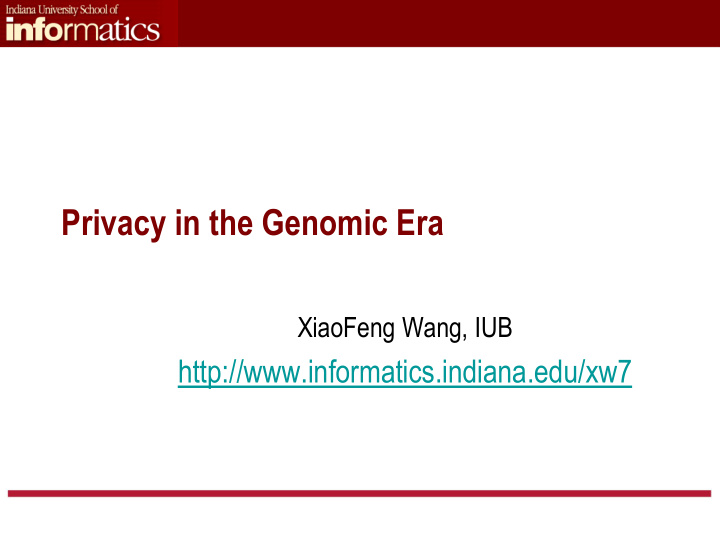



Privacy in the Genomic Era XiaoFeng Wang, IUB http://www.informatics.indiana.edu/xw7
Genomic Revolution Fast drop in the cost of genome-sequencing 2000: $3 billion Mar. 2014: $1,000 Genotyping 1M variations: below $200 Unleashing the potential of the technology Healthcare: e.g., disease risk detection, personalized medicine Biomedical research: e.g., geno-phono association Legal and forensic DTC: e.g., ancestry test, paternity test ……
Genome Privacy Privacy risks Genetic disease disclosure Collateral damage Genetic discrimination …… Protection Clear access policies Accountability Data anonymization Best practice for data privacy Privacy awareness ……
For More Information Privacy and Security in the Genomic Era By M Naveed, E. Ayday, E. Clayton, J. Fellay, C. Gunter, JP Hubaux, B. Malin and X. Wang Available at http://arxiv.org/pdf/1405.1891v1.pdf
Technical Challenges Dissemination: anonymization is difficult ! Extremely high dimensions Hard to balance between privacy and utility Computing: big data analysis Beyond the capability of existing secure computing technologies
Secure Elastic Read Mapping and Filtering Reference Genome (about 6 billion bps for two strands) T A G G C A C T G A C T T T G A A A G G T C C A A G T G A T C T T T G A A L-mer A G T G A T C T T T G A A T 10 million Reads (about 100 bps each) A C T G A C T T T G A A A A C T G A C T T T G A A A A C T G A C T T T G A A A A C T G A C T T T G A A A Next Generation DNA Sequencer
Big Data Analysis Technical Challenges Millions of reads and a reference of billions of nucleotides Edit-distance based alignment Cloud solutions Cost of sequencing < cost of mapping within organizations Cloud computing is the only solution Privacy NIH disallows reads with human DNA to be given to the public Cloud
Privacy-preserving Genomic Data Sharing Old problems: Statistical inference control, access control, query auditing… However, genome data are special: Special structures, e.g. linkage disequilibrium Existence of reference genomic data that are publicly available (e.g. large population studies as HapMap, WTCCC, 1000 Genome) An example: Homer’s attack and NIH’s responses
Our Research Our prior discovery: ID from GWAS publications Allele Frequencies Test statistics Statistical Identification LD statistics SNP Sequences Pair-wise allele frequencies Research on the risk advisory system for genome data sharing Red (risky), Yellow (potentially risky), Green (safe) Research on DNA data protection Balance between risk mitigation and data utility
For More Information 1. Choosing Blindly but Wisely: Differentially Private Solicitation of DNA Datasets for Disease Marker Discovery 2014 JAMIA 2. Large-Scale Privacy-Preserving Mappings of Human Genomic Sequences on Hybrid Clouds 2012 NDSS 3. To Release or Not to Release: Evaluating Information Leaks in Aggregate Human- Genome Data 2011 ESORICS 4. Learning Your Identity and Disease from Research Papers: Information Leaks in Genome Wide Association Study 2008 CCS
Community Challenges on Genome Privacy !
Challenge 2014 Theme : Genome Data Anonymization and Sharing Protecting SNP sequences: 200 individuals, 311 to 610 SNPs Protecting GWAS results: 201 cases/174 controls, 5000 to 106,129 SNPs Participants : U Oklahoma, UT Dallas, McGill, UT Austin and CMU Outcomes : evaluated by a biomedical and security panel Great promising for sharing GWAS results: Austin won the competition Difficulty in sharing raw data: existing techniques cannot preserve data utility
Challenge 2015 ! Objective: Find out how close secure computing technologies are in supporting real-world genomic data analysis Challenges: Secure outsourcing: HME-based analysis on encrypted genome sequences (GWAS analysis, sequence comparison) Secure collaboration: SMC-based data analysis across the Internet Deadline: Registration is now open Deadline for submitting the result (code): March 1 st . Workshop: March 16 at UCSD
HOW to PARTICIPATE Goto: http://www.humangenomeprivacy.org
Acknowledge NIH R01 (1R01HG007078- 01): “Privacy Preserving Technologies for Human Genome Data Analysis and Dissemination” NSF-CNS-1408874: “Broker Leads for Privacy-Preserving Discovery in Health Information Exchange”
Recommend
More recommend